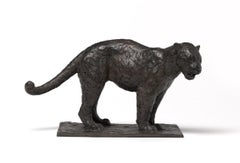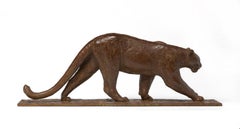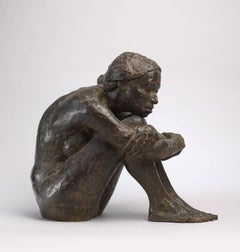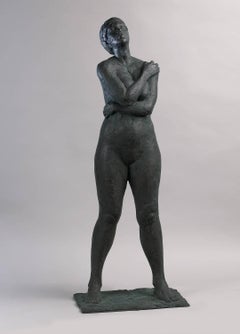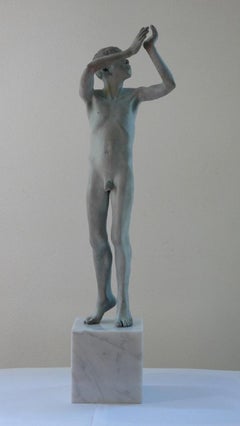Peter Brooke Art
American, b. 1961
Peter Brooke was born and raised in the harbor town of Scarborough in North Yorkshire, England in 1965. After earning a Bachelor of Fine Arts degree in television and film production from Manchester Polytechnic, he moved south to London and began his professional career as a sculptor and designer for Jim Henson’s Creature Shop. After moving to the United States, he began to exhibit bronze sculptures of animals. Brooke studied with contemporary masters George Carlson and Floyd De Witt. His early classical influences included Rodin, Epstein, Moore; animal portraits influenced by Rembrandt, Bugatti and Jonathan Kenworthy; also Degas and Giacometti. The skilled quality and convincing character portrayals of these sculptures were quickly recognized. His work has been shown in many museum and gallery exhibitions throughout the country. Brooke’s powerful interpretations of the human figure have also gained him notoriety. Besides his success in fine art, Brook has a successful industry career. He was a Creative Supervisor for the Academy Award-winning Jim Henson’s Creature Shop where he has completed work for films such as, “Where the Wild Things Are”, “The Producers”, “Frances”, “Cats and Dogs”, “Stuart Little 2”, “Dr. Doolittle”, and many more.
Peter Brooke resides in Los Angeles with his wife, Charlotte, and their son, George. He is also a jazz saxophonist.
Professional Memberships
Sculptor Member of the California Art Club
Awards and Honors
2004 Gold Medal Award for Best Sculpture, California Art Club’s 94th Annual Gold Medal Juried Exhibition held at the Pasadena Museum of California Art
1998 Award of Excellence, the Society of Animal Artists Annual Exhibition
Selected Press
Newspapers & Magazines: Southwest Art Magazine
TV Programs: Wildlife Art News and Art-Talk(Biography provided by American Legacy Fine Arts)
to
7
6
4
2
1
1
1
Jaguar
By Peter Brooke
Located in Pasadena, CA
Acquired by the gallery directly from the artist
Artist Statement
“I like to think of the jaguar as the welterweight of big cats. Even though this sculpture is small my aim was to c...
Category
2010s Realist Peter Brooke Art
Materials
Bronze
Walking Leopard
By Peter Brooke
Located in Pasadena, CA
Acquired by the gallery directly from the artist
Artist Statement
“By exploring the forms in this piece, and given the simplicity of the gesture, I can directly address the concept ...
Category
2010s Realist Peter Brooke Art
Materials
Bronze
Seated Figure
By Peter Brooke
Located in Pasadena, CA
Provenance
Acquired by the gallery directly from the artist
Exhibitions
Beauty and the Power of Sculpture, American Legacy Fine Arts, Octobe...
Category
Early 2000s Realist Peter Brooke Art
Materials
Plaster
Michael Standing
By Peter Brooke
Located in Pasadena, CA
Provenance
Acquired by the gallery directly from the artist
EXHIBITIONS
California Art Clubs 95th Annual Gold Medal Juried Exhibition
April 2 - 23...
Category
Early 2000s Realist Peter Brooke Art
Materials
Bronze
Goddess
By Peter Brooke
Located in Pasadena, CA
Signed Edition
#1 of 6
Provenance
Acquired by the gallery directly from the artist
Description
Feeling the sun’s warmth enveloping her body, Peter Brooke’s bronze “Goddess” express...
Category
Early 2000s Realist Peter Brooke Art
Materials
Bronze
Hippos on the Mara
By Peter Brooke
Located in Pasadena, CA
Provenance
Acquired by the gallery directly from the artist
Description
The picturesque Mara River flows through the plains of Tanzania and Kenya and lies across the Serengeti/Maasai Mara reserve. The area is famous for its Great Migration...
Category
Early 2000s Realist Peter Brooke Art
Materials
Bronze
Mayan Warrior
By Peter Brooke
Located in Pasadena, CA
Provenance
Acquired by the gallery directly from the artist
Description
Peter Brooke's Mayan Warrior depicts a solemn and dignified military subject. Historically, few Mayan warrior...
Category
1990s Realist Peter Brooke Art
Materials
Bronze
Related Items
Volo Standing Male Nude Sculpture Figure Bronze Boy - In Stock
By Wim van der Kant
Located in Utrecht, NL
Volo Standing Male Nude Sculpture Figure Bronze Boy - In Stock
Volo is a standing male nude figure in bronze, a boy reaching, in brown patina. This sculpture is suitable for indoors ...
Category
21st Century and Contemporary Contemporary Peter Brooke Art
Materials
Bronze
Free Shipping
H 15.75 in W 3.94 in
Gallulus Bronze Sculpture Nude Boy Male Figure Green Patina Marble Stone
By Wim van der Kant
Located in Utrecht, NL
Gallulus Bronze Sculpture Nude Boy Male Figure Green Patina Marble Stone
Wim van der Kant (1949, Kampen) is a selftaught artist. Next to his busy profess...
Category
21st Century and Contemporary Contemporary Peter Brooke Art
Materials
Marble, Bronze
Free Shipping
H 16.54 in W 7.88 in
Chanson d'Amour
By Donald De Lue
Located in Boston, MA
Donald De Lue, American (1897-1988). Chanson d'Amour, 1986. Bronze, 15 1/2 inch height.
Bronze with Renaissance Brown patina, as well as Pewter patina on instrument. Number 1 in an...
Category
20th Century Art Deco Peter Brooke Art
Materials
Bronze
"At Last, " Sculpture
By Bill Starke
Located in Denver, CO
Bill Starke's "At Last" is a limited edition, bronze sculpture created by Bill Starke depicting a male figure with out-stretched arms.
( 3/85 )
About the artist:
Human beings int...
Category
2010s Realist Peter Brooke Art
Materials
Marble, Bronze
Industrial Machine Age American Scene WPA Mid 20th Century 1939 SF World's Fair
Located in New York, NY
Industrial Machine Age American Scene WPA Mid 20th Century 1939 SF World's Fair
HAIG PATIGIAN (American/Armenian, 1876-1950)
Aeronautics Pediments
Two Plaster Casts, c. 1930s
each 13.25 x 14.75 x 6 inches
It's possible these moquettes were created for the 1939 World's Fair, the Golden Gate International Exhibition in San Francisco.
Provenance: Private Collection of Lois M. Wright, Author of "A Catalogue of the Life Works of Haig Patigian, San Francisco Sculptor, 1876-1950),” 1967
Loan to Oakland Museum of California (Oakland, CA)
BIO
Haig Patigian is noted for his classical works, which are especially numerous in public venues in San Francisco, California. Patigian was born in Van, Armenia, which at that time was under Turkish rule. Haig was the son of Avedis and Marine Patigian, both teachers in the American Mission School there. He and his older brother showed an aptitude for art early on and were encouraged by their parents. Their father himself had taken up the new hobby of photography. The 1880s were harsh times, however, for many Armenians under an oppressive rule by the Turkish government. Many people were fleeing to the safety of the United States. Suspicious Turkish authorities accused his father of photographing city structures for the Russian government, and in 1888 he fled for his life to America.
Haigs father made his way to Fresno, California, and began life anew as a ranch hand. Within two years he sent for his wife, as well as Haig, his three sisters and brother, and in 1891 the Patigians made the journey from Armenia. Haigs father, an industrious man, worked on various farms, and eventually bought his own ranch and vineyard. It was among fertile farmland of Fresno that Haig grew up.
Young Haigs education consisted of teachings by his parents and by intermittent attendance in public schools. Although he had dreams of becoming an artist, he did not have the opportunity for formal study of art, and began working long days in the vineyards around Fresno.
At age seventeen, Haig made a step towards his dreams and apprenticed himself to learn the trade of sign painting. In his spare time he nurtured his interest in art by painting nature and life scenes with watercolors and oil paints. When his sign-painting mentor left Fresno, Haig opened his own shop and made a name for himself in the town. San Francisco, in the meantime, had been attracting artists since the Gold Rush and had become a thriving art center. Within a few years, Haig had put aside several hundred dollars to move to San Francisco, joining his brother who was already working there as an illustrator.
In 1899, when he was twenty-three, Haig had saved enough money to enroll at the Mark Hopkins Art Institute in San Francisco. Like many aspiring artists of his time, Patigian supported himself by working as a staff artist in the art department of a local newspaper, and in the winter of 1900, nearing his 24th birthday, Haig began work for the San Francisco Bulletin, producing cartoons, black and white illustrations, as well as watercolors.
In 1902 tragedy struck Haig and his family. His 29-year-old brother died of pneumonia, and then his frail mother died a short time later. Five months more saw his youngest sister, just out of high school, die too. Saddened and depressed, Haig moved out of the studio he had shared with his brother, and into a dilapidated studio in a poor section of town. During this time of sadness, Haig fed a growing interest in sculpture.
In 1904 Haig created what he later called his "first finished piece in sculpture". The work, called "The Unquiet Soul", depicted a man thrown back against a rock while waves lash at his feet. The body was tense and twisted, with one hand, in Haig's own words, "searchingly leaning and clutching the rock, while the other masks his troubled head".
The Press Club of San Francisco, which Haig had joined in 1901, put "The Unquiet Soul" on exhibition and local headlines proclaimed "Local Newspaper Artist Embraces Sculptor's Art", and "First Work Predicts Brilliant Future". With the support of friends and community acclaim, the young illustrator left his newspaper job and became a professional sculptor.
The path of his new career was not easy though. Haig had never made much money working for the newspaper and his father needed help with growing debt from funeral expenses and business problems. From time to time Haig sold some artwork, but also occasionally borrowed from friends to pay the rent. He was the classic 'starving artist'.
In the spring of 1905 a white-bearded 81-year-old stranger knocked on Haig's door. It was George Zehndner, from Arcata, California. Zehndner had been born in Bavaria, Germany in 1824, the son of a farmer. In 1849 he had come to America looking for prosperity, settling in Indiana, where he worked on a farm and learned English. He found his way to the West Coast in 1852. Penniless, he worked in various jobs from San Francisco to Sacramento, then found some luck working in the gold fields of Weaverville in Trinity County, and eventually moving to a farm on 188 acres near Arcata. In his 77th year in May of 1901, Zahndner had taken a trip to San Jose, where he stood in a crowd to see a man he thought much of, President William McKinley. McKinley was popular as 'the first modern president' partially because he realized going out to meet the common person increased his support. In September of that year, however, an anarchist assassinated the president while he stood in a receiving line at the Pan-American Exhibition in Buffalo, New York. Soon after, the city of San Jose erected a statue of the slain president in St. James Park. Zehndner took a second trip to San Jose where he visited the McKinley monument. Touched, Zehndner decided that, no matter the cost, his town of Arcata too would memorialize McKinley.
George Zehndner had read about Haig in a newspaper article and asked if Patigian would create a heroic statue of the late President McKinley for Arcata. When asked how much it would cost, Haig responded, despite his borderline poverty, with the fabulous sum of $15,000. Zehndner agreed. The President was to be portrayed standing, wearing an overcoat, with his feet planted squarely on the ground. In the finished statue, one hand is held out before him in a typical posture of speaking, with the other hand holding the speech as his side. The 9-foot statue...
Category
1930s American Modern Peter Brooke Art
Materials
Plaster
"Doubt" figurative sculpture bronze limited at 8 pieces 16x16x16cm 2009
By Emmanuelle Vroelant
Located in Roscoff, FR
"Doubt" bronze figurative sculpture limited at 8 pieces 16x16x16cm left n° 3/8 certificate emmanuelle vroelant
in 2009 Emmanuelle Vroelant decided to start scu...
Category
21st Century and Contemporary Realist Peter Brooke Art
Materials
Bronze
H 6.3 in W 6.3 in D 6.3 in
2 Sculptures: "The Power" & "The Glory" WPA Depression WWII era mid 20th century
By Agnes Yarnall
Located in New York, NY
2 Sculptures: "The Power" & "The Glory" WPA Depression WWII era mid 20th century by Agnes Yarnall circa 1940s.
Sculptor, painter, poet and artistic historian, Agnes Yarnall has, since the age of six been breathing life into her art.
Renowned as a sculptor, whose commissioned portrayals of contemporary celebrities are prized. She has sculpted Judith Anderson, Edna St. Vincent Millay, Carl Sandburg...
Category
1940s American Modern Peter Brooke Art
Materials
Plaster
Antique Horse Bronze Trotting Stallion Isidore Jules Bonheur (France, 1827-1901)
By Isidore Jules Bonheur
Located in SANTA FE, NM
Antique Horse Bronze
Portrait of a Trotting Stallion
Isidore Jules Bonheur (France, 1827-1901)
Cast bronze mounted on a rectangular plinth with dark brown patina,
Signed: I. BONHEUR
17 x 11 3/4
A brilliant exploration of a stallion in full trot. The patina is a deep, warm walnut brown with honey-colored tones.
Isidore Bonheur was best known and the most distinguished of the 19th century French animalier sculptors. Isidore, the younger brother of Rosa Bonheur and older brother of Auguste, began his studies of painting initially with his father, who was friends with Francisco Goya. By 1848 he debuted at the Paris Salon having discontinued animal and landscape painting to concentrate on creating sculptures and in 1849, Bonheur enrolled at the Ecole des Beaux Arts. He won medals at the Paris Salon in 1859 and did so again in 1865 and in 1869. After entering the Exposition Universelle 1855, he won the Gold Medal in 1889. In the 1870s exhibited in the London at the Royal Academy of Arts where he earned great prestige and won the coveted Medaille d’Or. After winning numerous other medals and prizes, Bonheur was awarded the Legion d' Honneur in 1895 and he was Knighted in Portugal, Spain and France. Bonheur continued exhibiting at the Paris Salon until 1899.
Many of his bronzes were fabricated at the foundry owned by Hippolyte Peyrol, Bonheur's brother-in-law by marriage to Isidore’s youngest sister Juliette Bonheur. The Peyrol casts for both Rosa and Isidore are exceptionally well executed which suggests a strong working relationship between the founder and sculptor. There is little doubt that Isidore Bonheur was an acute observer of nature; his animals were not anthropomorphized but modelled to catch movement or posture characteristics of the particular species he was sculpting. He achieved this most successfully with his sculptures of horses which are usually depicted as relaxed rather than spirited. These figures are among his most renowned works and his equestrian models became very popular, particularly among the British aristocracy.
An acute observer of nature, his sculptures reflect his commitment to the Realist school - with precise detailing of the movements of animals in their natural habitats. Ultimately, His naturalistic studies of animals are now some of the most highly sought after works by any of the animalier. He was possibly inspired by his many visits to the Buffalo Bill Wild West Show...
Category
1870s Realist Peter Brooke Art
Materials
Bronze
"Untitled" bronze sculpture of seated female figure by artist Felipe Castañeda
By Felipe Castañeda
Located in Boca Raton, FL
"Untitled" bronze sculpture of a female nude by artist Felipe Castañeda. Inscribed F. Castañeda 1984 P/A on base.
Category
1980s Modern Peter Brooke Art
Materials
Bronze
Rare, Antique, Life-Size Dog Bronze of a Chihuahua "Lydie" Charles Valton. 1890s
By Charles Valton
Located in SANTA FE, NM
Antique Bronze Dog Sculpture
Chihuahua "La Petite Belle Lydie"
Charles Valton (French, 1851-1918)
Circa 15 1/2 x 10 1/4 x 7
Lydie is a Chihuahua making her a very rare image from ...
Category
Late 19th Century Realist Peter Brooke Art
Materials
Bronze
H 15.5 in W 10.25 in D 7 in
"Pioneer Family" WPA American Modernism Plaster Maquette Realism 20th Century
By William Zorach
Located in New York, NY
"Pioneer Family," 23 1/2 x 16 1/4 x 10 3/4 inPlaster. c. 1927. Unsigned. Realism
The Smithsonian has a cast of this sculpture in its collection. Pictured on the cover of “The Sculpt...
Category
1920s American Modern Peter Brooke Art
Materials
Plaster
Bronze Bust of a Woman
Located in Milford, NH
A fine cast patinated bronze bust of a woman with her hair tied back by American artist Andrew Coppola (1941-1992). Coppola was an active artist in Connecticut, known for his figura...
Category
1970s Realist Peter Brooke Art
Materials
Bronze
Peter Brooke art for sale on 1stDibs.
Find a wide variety of authentic Peter Brooke art available for sale on 1stDibs. You can also browse by medium to find art by Peter Brooke in bronze, metal, plaster and more. Not every interior allows for large Peter Brooke art, so small editions measuring 8 inches across are available. Customers who are interested in this artist might also find the work of Christopher Slatoff, Gary Sczerbaniewicz, and Pierre Jules Mêne. Peter Brooke art prices can differ depending upon medium, time period and other attributes. On 1stDibs, the price for these items starts at $5,600 and tops out at $18,000, while the average work can sell for $8,800.
